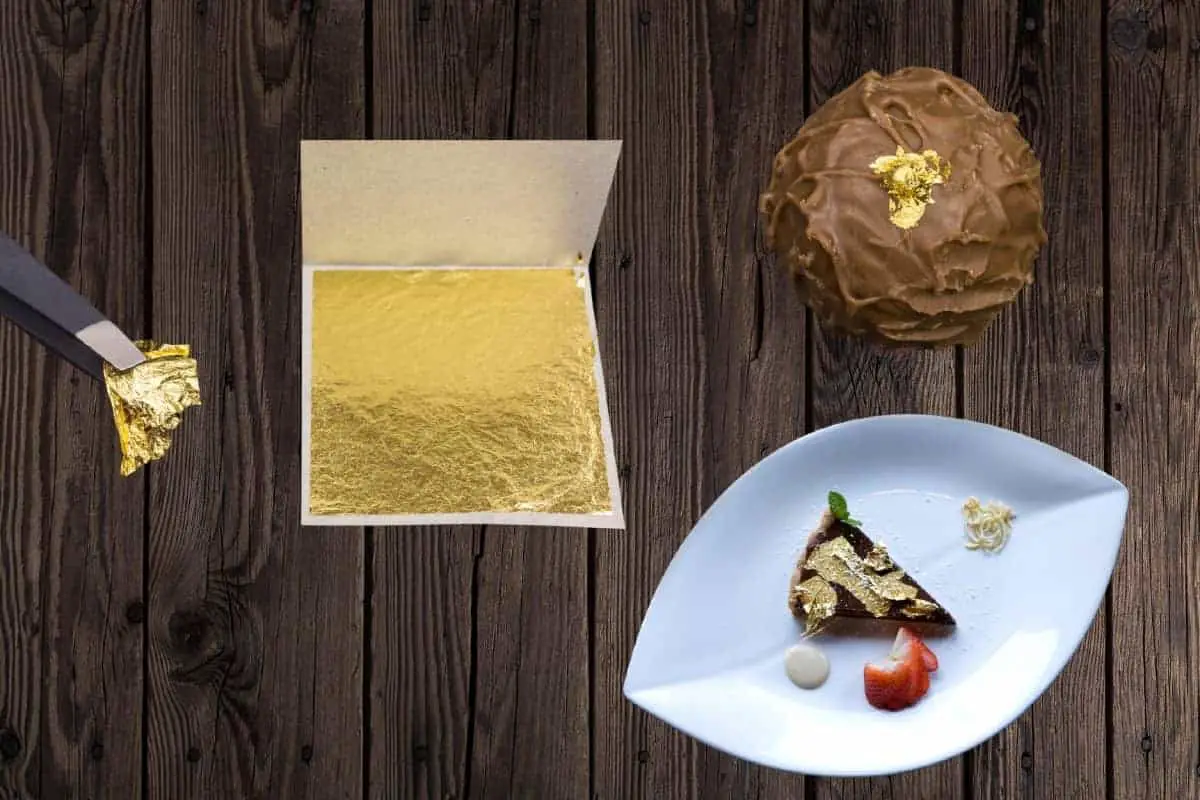A Taste of Gold: Exploring the World of Edible Gold
Discover why this ultimate luxury is the latest food trend
By Jane Pardo | Updated February 14, 2023
Edible gold is a shiny food garnish that adds a luxurious flair to meals, desserts, and drinks.
But what is edible gold made of, and is it safe for consumption?
Continue reading to learn interesting facts about this lavish food embellishment.
Table of contents
What is edible gold?
Edible gold is a consumable form of gold made of high-karat, food-grade gold, ranging from 22k to 24k gold. It’s a popular luxury garnish for desserts and beverages, from delectable cakes and cookies to fancy wine and cocktails. Edible gold leaf is ultra-thin and safe to consume.
What you need to know:
- The US and EU authorize edible gold as a food additive.
- Edible gold is biologically inert. This means it goes through the digestive system without absorption or unwanted health effects.
- Unlike many metals, edible gold doesn’t oxidize or corrode in humid air, making it suitable for food and drinks.
Edible gold has an indefinite shelf life, so it doesn’t expire.
History of edible gold
Edible gold has a very long, interesting history.
- Ancient Egyptians used it for spiritual and physical purification over 5,000 years ago.
- Court physicians in eastern countries like Japan and China added it to medicines.
- Medicinal gold pills and powder were popular during the Renaissance era.
- Edible gold was a famous food decoration and symbol of wealth in European countries.
Today, it’s popular in cuisines and various other applications.
Edible gold production process
Certified facilities process edible gold as a food decoration.
Edible gold must meet food safety standards to prevent unwanted health issues. But crafting edible gold is an arduous process. It usually gets hammered, tirelessly pounded and rolled, and turned into powder form.
Here’s the process for making edible gold leaf:
- Facilities melt pure gold at over 1,800 degrees Fahrenheit and pour it into bar-shaped molds.
- Then, artisans stretch these gold bars into incredibly thin strips using cylinders and rollers.
- The gold sheets go through heating and cooling cycles to decrease tension and make them much thinner.
- The thin sheets are cut into small squares. They must be relentlessly pounded using mechanical hammers until they are 0.0001 millimeters thick.
- Artisans cut the gold leaf by hand with a double-bladed knife and insert it into paper booklets.
Gold is a very malleable and ductile precious metal, making it easy to reshape or stretch into extremely thin sheets.
Manufacturers sometimes add very small amounts of copper and silver to give edible gold structural strength and make it easier to apply. 24k edible gold contains 99.9% pure gold and 0.01% pure silver.
Uses of edible gold
Edible gold is an elegant decoration that looks stunning on just about everything.
It has multiple versatile uses:
- Toppings on food and drinks: Edible gold is popular in haute cuisine, especially in high-end restaurants serving lavish gourmet meals. Bakeries add it to cakes and pastries for a luxurious touch. You can also use it to embellish your homemade dessert and pastries, from chocolate cakes and blueberry cheesecakes to French macarons and lemon vodka cocktails.
- A shimmering addition to arts and crafts: Some people use edible gold in artistic projects like nail art designs, tableware, and smartphone cases.
- A glittery ingredient in skin care products: Edible gold has become a fancy ingredient in facial masks, serums, perfume, lotions, and other products.
Edible gold leaf products are available online and in specialty baking supply stores.
Types of edible gold
Edible gold is an attractive embellishment that comes in several forms.
The following types of edible gold leaf are excellent for personal and commercial use:
Edible gold loose leaf sheets
- Very delicate
- Loose pages
- Ideal for small projects, like decorating cakes and muffins
Edible gold flakes
- Very delicate
- Small flakes
- Requires anti-static tweezers for smooth application
- Floats on drinks
Edible gold dust
- Comes in powder form
- Dry brush application
- Ideal for retouching, particularly on carved and irregular surfaces
- Also perfect to mix with wines, liquors, and cocktails
Note: Check the product packaging carefully. Some gold leaf decorations are actually inedible, gold-colored foil. Be sure to pick authentic edible gold leaf crafted from 22k to 24k gold, as lower fineness may not be ideal for consumption.
FAQs
What’s the taste of edible gold?
Edible gold tastes slightly metallic on its own. It becomes a flavorless ingredient when added as a food garnish.
How do I apply edible gold?
Edible gold is thin and delicate. It’s best to apply it with a brush or a pair of tweezers. Avoid direct touching after application. Your hands should be clean and dry when decorating with edible gold.
Final thoughts
Edible gold brings an exquisite glimmer to almost anything it touches.
It’s the perfect garnish to impress and stand out, whether you’re adding a touch of glamour to a wedding cake or elevating your savory culinary creations.
Written by Jane Pardo

Jane Pardo is our senior gold & silver expert. Jane lends insight into precious metals investing, collecting, testing, and maintenance.
Trending posts under
As participant in an affiliate advertising program, we earn from qualifying purchases.